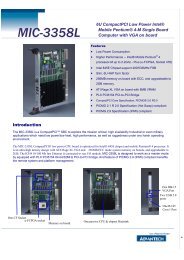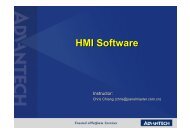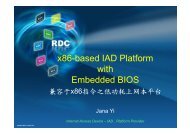industrial wireless book special edition - Networking ...
industrial wireless book special edition - Networking ...
industrial wireless book special edition - Networking ...
Create successful ePaper yourself
Turn your PDF publications into a flip-book with our unique Google optimized e-Paper software.
For several reasons, including cost reduction,<br />
guaranteeing an acceptable Packet Error Rate<br />
(PER), and microcontroller buffering constraints,<br />
IEEE 802.15.4 only supports a 127 byte MTU. To<br />
support the IPv6 1280 byte MTU, datagrams<br />
must thus be fragmented before they can be<br />
delivered to the link layer. With RFC4944, the<br />
IETF has defined the 6LoWPAN adaptation layer<br />
to support fragmentation.<br />
Fragmented datagrams also provide additional<br />
opportunity for more effective buffering<br />
techniques when forwarding datagrams. For<br />
example, fragments can be delivered before a<br />
node reassembles the entire datagram, allowing<br />
nodes with severe memory constraints to<br />
forward complete datagrams.<br />
Extending Neighbour Discovery<br />
IPv6 ND is currently defined for operation only<br />
on links that support a single broadcast<br />
domain. As such, many of the ND primitives<br />
rely on multicast to discover and communicate<br />
with neighbouring nodes on the same link. For<br />
this reason, IPv6 Neighbour Discovery (ND)<br />
does not map well to smart objects connected<br />
by a <strong>wireless</strong> network that spans multiple hops.<br />
One option involves emulating a single<br />
broadcast domain over the entire <strong>wireless</strong><br />
network, allowing support for IPv6 ND as<br />
specified today. However, for networks that<br />
reach any reasonable scale, a simple multicast<br />
is prohibitively expensive as the message must<br />
be delivered to all nodes within the network.<br />
An alternative solution is to concentrate ND<br />
operations at routers that serve as egress<br />
points for the network. By relying on egress<br />
routers, ND can now use unicast communication<br />
which is much more efficient than<br />
multicast in <strong>wireless</strong> networks. The use of edge<br />
routers to support ND is currently being<br />
specified within the IETF.<br />
An IPv6 Ready protocol stack can be implemented<br />
in approximately 11.5KB of ROM and<br />
1.8KB of RAM. To support the 1280 byte<br />
minimum MTU, a single packet buffer requires<br />
1280 bytes of RAM.<br />
Of the remaining data structures, the<br />
neighbour cache requires 35 bytes per<br />
neighbour, the prefix list requires 23 bytes per<br />
prefix, the router list requires seven bytes per<br />
router, and the interface address list requires<br />
approximately 100 bytes.<br />
Table 1 provides a breakdown of the typical<br />
memory requirements for individual components.<br />
(Fragmentation and per neighbour buffering are<br />
not included). Neighbour Discovery consumes<br />
the largest portion of the complexity.<br />
Together with a complete run time (timers,<br />
scheduler, etc.) as well as RFC compliant UDP<br />
and TCP protocols above, an OS that provides<br />
a complete IPv6 network stack can be implemented<br />
within 35KB of ROM and 3KB of RAM.<br />
Complete IPv6 based applications fit comfortably<br />
within a microcontroller providing only<br />
64KB of ROM and 4 to 8KB of RAM.<br />
sponsored by Advantech<br />
<strong>industrial</strong> ethernet <strong>book</strong><br />
Function ROM RAM<br />
ND Input/Output<br />
ND structures<br />
Network interface management<br />
Stateless address autoconfiguration<br />
IPv6 (headers processing, etc)<br />
Packet buffer (Ethernet case)<br />
ICMPv6<br />
4800<br />
2128<br />
1348<br />
372<br />
1434<br />
0<br />
1406<br />
20<br />
238<br />
118<br />
16<br />
44<br />
1296<br />
16<br />
Total 11488 1748<br />
Table 1. Typical code and memory requirements for a<br />
complete IPv6 protocol stack<br />
Energy requirements<br />
Battery powered smart objects are constrained<br />
not only in memory, but in energy as well. With<br />
appropriate link layer mechanisms and experimental<br />
modifications to IPv6 (e.g. compression<br />
and ND optimisations), it is possible to<br />
implement an IPv6 network stack that consumes<br />
very little energy. In production deployments,<br />
an IPv6/802.15.4 network can operate at

















